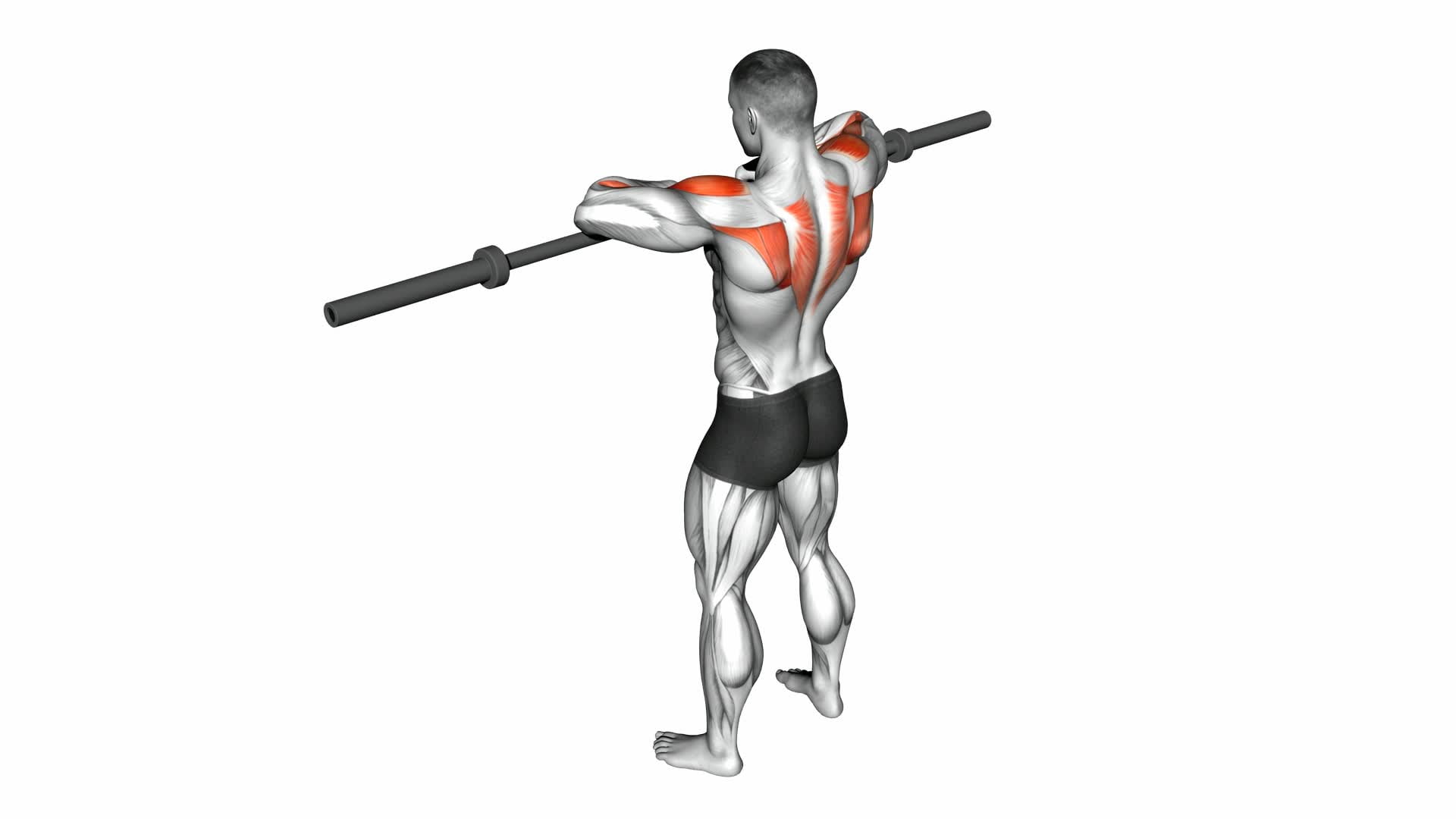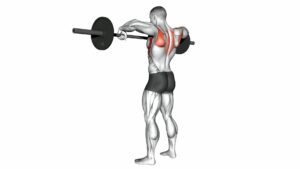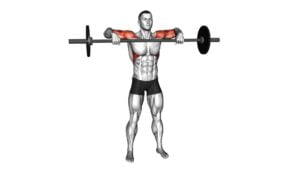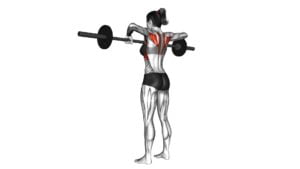Barbell Upright Row – Video Exercise Guide & Tips

Are you looking to improve your strength and build a strong upper body? The barbell upright row is a great exercise to add to your routine. In this video exercise guide, we will show you the proper form and technique, as well as common mistakes to avoid.
Watch This Exercise Video
We will also provide variations and modifications to suit different fitness levels. Increase your intensity and progression with our expert tips. Remember to prioritize safety and injury prevention throughout your workout.
Let's get started!
Key Takeaways
- The barbell upright row targets the shoulders, deltoids, and trapezius muscles.
- Proper form and technique are crucial to avoid common mistakes and maximize the benefits of the exercise.
- There are various variations and modifications of the barbell upright row to target different muscle groups and accommodate different fitness levels.
- Increasing intensity and progression can be achieved through gradually increasing weight, focusing on form, and incorporating additional challenges such as supersets or drop sets.
Benefits of the Barbell Upright Row
You can experience numerous benefits from including the barbell upright row in your workout routine. This exercise primarily targets your shoulders, specifically the deltoids and trapezius muscles. By performing the barbell upright row, you can strengthen and tone these muscles, leading to improved shoulder stability and posture.
One of the key benefits of the barbell upright row is its ability to enhance upper body strength. As you pull the barbell upwards towards your chin, your deltoid muscles are engaged, allowing you to build both strength and size in your shoulders. This exercise also activates the trapezius muscles, which play a crucial role in maintaining proper posture and shoulder alignment.
In addition to its strength-building benefits, the barbell upright row offers variations that can target different muscle groups. For example, you can vary your grip width to emphasize different parts of the shoulders. A wider grip will target the lateral deltoids, while a narrower grip will target the front deltoids. You can also incorporate a slight forward lean or perform the exercise with dumbbells to further challenge your muscles.
Incorporating the barbell upright row into your workout routine can lead to improved shoulder strength, stability, and posture. By utilizing variations, you can target different muscle groups and achieve a well-rounded shoulder workout.
Proper Form and Technique for the Barbell Upright Row
To perform the barbell upright row with proper form and technique, it's important to focus on your body positioning and movement. This exercise primarily targets the shoulders and upper back muscles, providing benefits such as improved shoulder strength, posture, and upper body definition.
To begin, stand with your feet shoulder-width apart and grip the barbell with an overhand grip, hands slightly narrower than shoulder-width apart. Keep your chest up, shoulders back, and engage your core throughout the movement.
Start by pulling the barbell straight up towards your chin, leading with your elbows and keeping them higher than your wrists. As you lift, exhale and squeeze your shoulder blades together. Avoid using momentum or swinging the barbell, and maintain control as you lower it back down to the starting position.
It's crucial to use an appropriate weight for your fitness level and to ensure proper equipment, such as a barbell with a comfortable grip and enough weight plates to challenge your muscles without sacrificing form. Remember, always prioritize safety and consult a fitness professional if you're unsure about your form or technique.
Common Mistakes to Avoid During the Barbell Upright Row
When performing the barbell upright row, it's important to pay attention to your hand placement and elbow positioning technique. Avoid gripping the bar too narrow or too wide, as this can put unnecessary strain on your wrists and shoulders.
Keep your elbows pointed outwards and avoid letting them drop below your wrists to ensure proper form and maximize the effectiveness of the exercise.
Proper Hand Placement
For the barbell upright row, it's essential to have proper hand placement to avoid common mistakes. The correct hand grip is crucial for maximizing shoulder activation and preventing injury.
Place your hands on the barbell slightly wider than shoulder-width apart, with palms facing your body. This grip allows for a comfortable and secure hold on the barbell. Avoid gripping the bar too tightly, as this can restrict movement and lead to excessive strain on the wrists and forearms.
Additionally, make sure to keep your wrists in a neutral position throughout the movement, with neither excessive flexion nor extension. By maintaining proper hand placement, you can ensure proper form and minimize the risk of injury during the barbell upright row.
Elbow Positioning Technique
During the barbell upright row, focus on keeping your elbows close to your body for proper form and to prevent potential mistakes. Here are some tips to ensure correct elbow positioning:
- Avoid flaring your elbows out to the sides. This puts excessive stress on the shoulder joint and can lead to injury. Keep your elbows pointing down and slightly back throughout the movement.
- Engage your shoulder blades by squeezing them together. This helps to stabilize your shoulders and maintain proper alignment of the elbows.
- If you find it difficult to maintain proper elbow positioning, decrease the weight or use a narrower grip on the barbell. This will allow you to maintain better control and form.
- If the barbell upright row still causes discomfort or isn't suitable for you, there are alternative exercises you can try, such as dumbbell upright rows or cable upright rows. These variations may be more comfortable and provide similar benefits to the barbell upright row.
Variations and Modifications for the Barbell Upright Row
Explore different variations and modifications to enhance your Barbell Upright Row.
Adding variations and modifications to your workout routine can help target different muscle groups and prevent plateaus.
One variation you can try is the wide grip upright row. Instead of holding the barbell with a shoulder-width grip, widen your grip to target your deltoids and upper back muscles more intensely.
Another variation is the reverse grip upright row. Instead of the traditional overhand grip, use an underhand grip. This variation places more emphasis on the biceps and forearms.
You can also try using dumbbells instead of a barbell. This allows for a greater range of motion and can help improve overall shoulder stability.
To modify the exercise, you can use a resistance band instead of a barbell or dumbbells. This reduces the amount of weight and can be beneficial for beginners or those recovering from an injury.
Remember to always maintain proper form and listen to your body to prevent any injuries.
Incorporating these variations and modifications into your routine can help you achieve better results and keep your workouts challenging and engaging.
Tips for Increasing Intensity and Progression in the Barbell Upright Row
To increase the intensity and progression in the Barbell Upright Row, focus on gradually increasing the weight and challenging your muscles with each rep. Here are some tips to help you maximize your workout:
- Progressive Overload: Increase the weights you're lifting over time. Start with a weight that allows you to perform the exercise with proper form, but still challenges your muscles. As you get stronger, gradually increase the weight to continue challenging your muscles and promoting growth.
- Tempo Control: Pay attention to the tempo at which you perform the exercise. Slow down the lifting phase and control the lowering phase to increase the time your muscles are under tension. This can enhance muscle recruitment and promote muscle growth.
- Vary Grip Width: Experiment with different grip widths to target different areas of the shoulders and upper back. A wider grip can engage the outer delts more, while a narrower grip can focus on the traps and inner delts. Varying your grip width can help prevent plateauing and stimulate muscle growth.
- Superset with Other Exercises: To further increase intensity, consider supersetting the Barbell Upright Row with other exercises targeting the same muscle groups. This can help increase muscle fatigue and stimulate further growth.
Safety Precautions and Injury Prevention for the Barbell Upright Row
To ensure safety and prevent injuries, it's important to be mindful of proper form and technique while performing the Barbell Upright Row. Injury prevention should be a top priority when engaging in any exercise, and the Barbell Upright Row is no exception. Here are some safety precautions to keep in mind:
- Warm-up: Prior to starting the exercise, make sure to warm up your muscles. This will help increase blood flow and flexibility, reducing the risk of injury.
- Grip and hand placement: Use an overhand grip that's slightly wider than shoulder-width apart. This will ensure stability and minimize strain on the wrists and elbows.
- Posture: Maintain a neutral spine throughout the exercise. Avoid rounding your shoulders or arching your back, as this can lead to muscle imbalances and potential injuries.
- Range of motion: Avoid excessive shoulder elevation or pulling the barbell too high. This can put unnecessary strain on the shoulder joint and increase the risk of impingement.
- Gradual progression: Start with a lighter weight and gradually increase the load as you become more comfortable and confident with the exercise. This will allow your muscles and joints to adapt and reduce the risk of overuse injuries.
Frequently Asked Questions
How Many Repetitions and Sets Should I Do for the Barbell Upright Row?
To determine the repetition and set guidelines for the barbell upright row, it's important to consider your fitness level and goals.
Generally, aim for 3-4 sets of 8-12 repetitions, using a weight that challenges you without compromising form.
However, there are variations of the upright row that can be incorporated, such as using dumbbells or cables.
Experiment with different rep and set schemes to find what works best for you and helps you achieve your desired results.
Can I Use Dumbbells Instead of a Barbell for the Upright Row Exercise?
Yes, you can definitely use dumbbells instead of a barbell for the upright row exercise. Dumbbell variations of this exercise offer several benefits.
They allow for a greater range of motion, engage more stabilizer muscles, and can help correct muscle imbalances. Additionally, using dumbbells can provide a different challenge to your muscles, making the exercise more versatile and effective.
Is the Barbell Upright Row Suitable for Beginners?
The barbell upright row is a great exercise for beginners to build upper body strength. It targets the shoulders, traps, and biceps, helping you develop a strong and defined upper body.
However, if you're a beginner and find the barbell too challenging, there are alternative exercises you can try. These include dumbbell upright rows, cable upright rows, or resistance band upright rows. These exercises provide similar benefits while allowing for more control and less strain on your joints.
Should I Be Feeling Any Specific Muscles Working During the Barbell Upright Row?
When performing the barbell upright row, it's important to focus on proper form and technique.
You should feel the muscles in your shoulders, specifically the deltoids, working during this exercise.
It's crucial to avoid common mistakes such as using too much weight or pulling the barbell up too high.
Can the Barbell Upright Row Help Improve My Posture?
Incorporating the barbell upright row into your workout routine can have several benefits, including improving your posture.
By targeting the muscles in your upper back and shoulders, this exercise can help strengthen and stabilize the muscles that support proper posture.
To perform the barbell upright row correctly and avoid injury, make sure to maintain good form, keep your elbows high, and avoid excessive weight that could strain your muscles or joints.
Conclusion
In conclusion, the barbell upright row is a beneficial exercise for targeting the shoulders, upper back, and arms.
By maintaining proper form and technique, avoiding common mistakes, and incorporating variations and modifications, you can maximize the effectiveness of this exercise.
Remember to gradually increase intensity and progression while prioritizing safety precautions and injury prevention.
Incorporate the barbell upright row into your workout routine to strengthen and tone your upper body muscles.

Author
Years ago, the spark of my life’s passion ignited in my mind the moment I stepped into the local gym for the first time. The inaugural bead of perspiration, the initial endeavor, the very first surge of endorphins, and a sense of pride that washed over me post-workout marked the beginning of my deep-seated interest in strength sports, fitness, and sports nutrition. This very curiosity blossomed rapidly into a profound fascination, propelling me to earn a Master’s degree in Physical Education from the Academy of Physical Education in Krakow, followed by a Sports Manager diploma from the Jagiellonian University. My journey of growth led me to gain more specialized qualifications, such as being a certified personal trainer with a focus on sports dietetics, a lifeguard, and an instructor for wellness and corrective gymnastics. Theoretical knowledge paired seamlessly with practical experience, reinforcing my belief that the transformation of individuals under my guidance was also a reflection of my personal growth. This belief holds true even today. Each day, I strive to push the boundaries and explore new realms. These realms gently elevate me to greater heights. The unique combination of passion for my field and the continuous quest for growth fuels my drive to break new ground.







